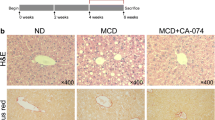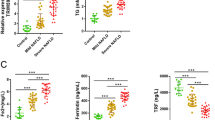Abstract
The cleavage and secretion of pro-inflammatory cytokines IL-1β and IL-18 is regulated by NLRP3 (NACHT, LRR, and PYD domain-containing protein 3) inflammasome activation. Kupffer cells (KCs) are implicated in the pathogenesis of various liver diseases, such as non-alcoholic fatty liver disease (NAFLD), alcoholic liver disease, and liver fibrosis. However, the role of NLRP3 played in the non-alcoholic steatohepatitis (NASH) has yet to be evaluated. In the present study, methionine–choline-deficient (MCD) diet was used to establish the mice NASH model. The expression levels of F4/80 and NLRP3 in liver tissues were evaluated, and the IL-1β and IL-18 in serum were also evaluated. KCs were isolated from wild-type (WT) mice and NLRP3 knockout (NLRP3−/−) mice and then randomly divided into two groups: the control and palmitic acid (PA) groups. The expression levels of NLRP3, ASC, and caspase-1 in KCs were determined by RT-PCR, western blotting, and immunofluorescence. The levels of IL-1β and IL-18 in the supernatant (SN) of KCs were evaluated by enzyme-linked immunosorbent assay (ELISA). We found that KCs and NLRP3 play pro-inflammatory roles in the progression of NASH, probably through secretions of IL-1β and IL-18 by KCs induced by PA. PA could act as a kind of damage-associated molecular patterns to elevate the messenger RNA and protein expression levels of NLRP3, ASC, and caspase-1 in KCs from WT mice. In the contrast, NLRP3 deletion could inhibit the NLRP3 inflammasome upregulation and activation in KCs induced by PA. Furthermore, the levels of pro-inflammatory cytokines IL-1β and IL-18 in the SN of KCs from WT mice were all elevated with the stimulation of PA, and the increase of these cytokines in the SN was blocked by NLRP3 deletion. In conclusion, our novel findings demonstrate that NLRP3 plays a pivotal role in NASH development and pro-inflammatory cytokines IL-1β and IL-18 secretion induced by PA stimulation, and NLRP3 might be an effective potential target for the treatment of liver inflammatory diseases associated with NLRP3 inflammasome activation.






Similar content being viewed by others
References
European Association for the Study of the Liver (EASL).; European Association for the Study of Diabetes (EASD).; European Association for the Study of Obesity (EASO). 2016. EASL-EASD-EASO Clinical Practice Guidelines for the management of non-alcoholic fatty liver disease. Journal of Hepatology 64 (6): 1388–1402.
Wree, A., L. Broderick, A. Canbay, H.M. Hoffman, and A.E. Feldstein. 2013. From NAFLD to NASH to cirrhosis-new insights into disease mechanisms. Nature Reviews. Gastroenterology & Hepatology 10: 627–636.
Wong, R.J., R. Cheung, and A. Ahmed. 2014. Nonalcoholic steatohepatitis is the most rapidly growing indication for liver transplantation in patients with hepatocellular carcinoma in the U.S. Hepatology 59: 2188–2195.
Day, C.P., and O.F. James. 1998. Steatohepatitis: A tale of two “hits”? Gastroenterology 114: 842–845.
Seki, E., and R.F. Schwabe. 2015. Hepatic inflammation and fibrosis: Functional links and key pathways. Hepatology 61: 1066–1079.
Pais, R., F. Charlotte, L. Fedchuk, P. Bedossa, P. Lebray, T. Poynard, et al. 2013. A systematic review of follow-up biopsies reveals disease progression in patients with non-alcoholic fatty liver. Journal of Hepatology 59: 550–556.
Latz, E., T.S. Xiao, and A. Stutz. 2013. Activation and regulation of the inflammasomes. Nature Reviews. Immunology 13 (6): 397–411.
Lamkanfi, M., and V.M. Dixit. 2012. Inflammasomes and their roles in health and disease. Annual Review of Cell and Developmental Biology 28: 137–161.
Strowig, T., J. Henao-Mejia, E. Elinav, and R. Flavell. 2012. Inflammasomes in health and disease. Nature 481 (7381): 278–286.
Elliott, E.I., and F.S. Sutterwala. 2015. Initiation and perpetuation of NLRP3 inflammasome activation and assembly. Immunological Reviews 265 (1): 35–52.
Csak, T., M. Ganz, J. Pespisa, et al. 2011. Fatty acid and endotoxin activate inflammasomes in mouse hepatocytes that release danger signals to stimulate immune cells. Hepatology 54 (1): 133–144.
Miura, K., L. Yang, N. van Rooijen, et al. 2013. Toll-like receptor 2 and palmitic acid cooperatively contribute to the development of nonalcoholic steatohepatitis through inflammasome activation in mice. Hepatology 57 (2): 577–589.
Jenne, C.N., and P. Kubes. 2013. Immune surveillance by the liver. Nature Immunology 14 (10): 996–1006.
Wynn, T.A., A. Chawla, and J.W. Pollard. 2013. Macrophage biology in development, homeostasis and disease. Nature 496 (7446): 445–455.
Li, P., K. He, J. Li, et al. 2017. The role of Kupffer cells in hepatic diseases. Molecular Immunology 85: 222–229.
Heymann, F., and F. Tacke. 2016. Immunology in the liver—from homeostasis to disease. Nature Reviews. Gastroenterology & Hepatology 13 (2): 88–110.
Tiniakos, D.G., M.B. Vos, and E.M. Brunt. 2010. Nonalcoholic fatty liver disease: Pathology and pathogenesis. Annual Review of Pathology 5: 145–171.
Szabo, G., and T. Csak. 2012. Inflammasomes in liver diseases. Journal of Hepatology 57 (3): 642–654.
Hoque, R., Y. Vodovotz, and W. Mehal. 2013. Therapeutic strategies in inflammasome mediated diseases of the liver. Journal of Hepatology 58 (5): 1047–1052.
Li, P.Z., J.Z. Li, M. Li, et al. 2014. An efficient method to isolate and culture mouse Kupffer cells. Immunology Letters 158 (1–2): 52–56.
Racanelli, V., and B. Rehermann. 2006. The liver as an immunological organ. Hepatology 43 (2 Suppl 1): S54–S62.
Lamkanfi, M., and V.M. Dixit. 2014. Mechanisms and functions of inflammasomes. Cell 157 (5): 1013–1022.
Jin, C., J. Henao-Mejia, and R.A. Flavell. 2013. Innate immune receptors: Key regulators of metabolic disease progression. Cell Metabolism 17 (6): 873–882.
Baffy, G. 2009. Kupffer cells in non-alcoholic fatty liver disease: The emerging view. Journal of Hepatology 51 (1): 212–223.
Stienstra, R., F. Saudale, C. Duval, et al. 2010. Kupffer cells promote hepatic steatosis via interleukin-1beta-dependent suppression of peroxisome proliferator-activated receptor alpha activity. Hepatology 51 (2): 511–522.
Bilzer, M., F. Roggel, and A.L. Gerbes. 2006. Role of Kupffer cells in host defense and liver disease. Liver International 26 (10): 1175–1186.
Broz, P., and V.M. Dixit. 2016. Inflammasomes: Mechanism of assembly, regulation and signalling. Nature Reviews. Immunology 16 (7): 407–420.
Guo, H., J.B. Callaway, and J.P. Ting. 2015. Inflammasomes: Mechanism of action, role in disease, and therapeutics. Nature Medicine 21 (7): 677–687.
Acknowledgments
The work was supported by the National Nature Science Foundation of China (No. 81400614 and No. 31370753).
Author information
Authors and Affiliations
Corresponding author
Ethics declarations
The animals received humane care in compliance with the institution’s guidelines, as outlined in the Guide for the Care and Use of Laboratory Animals prepared by the National Academy of Sciences. All experimental protocols described in this study complied with the ethics review committee for animal experimentation of Chongqing Medical University.
Conflict of Interest
The authors declare that they have no competing interests.
Rights and permissions
About this article
Cite this article
Cai, C., Zhu, X., Li, P. et al. NLRP3 Deletion Inhibits the Non-alcoholic Steatohepatitis Development and Inflammation in Kupffer Cells Induced by Palmitic Acid. Inflammation 40, 1875–1883 (2017). https://doi.org/10.1007/s10753-017-0628-z
Published:
Issue Date:
DOI: https://doi.org/10.1007/s10753-017-0628-z




